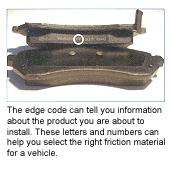Just about every brake pad or shoe you install has a cryptic code printed on the side of the friction material. As a technician, being able to read this code is just as important as the Dewey Decimal system is to a librarian.
 The “Edge Code” can tell you information about the product you are about to install. These letters and numbers can help you select the right friction material for a vehicle and its driver.
The “Edge Code” can tell you information about the product you are about to install. These letters and numbers can help you select the right friction material for a vehicle and its driver.
Edge Code is a language written by engineers, federal entities and industry associations. Like any language, edge coding has its own “grammar” that has been defined by standardized vehicle and laboratory tests.
SAE AND THE TWO-LETTER TANGO
If you are to take one thing away from this article, it should be how to read the letters that correspond with the friction levels of the brake compound. These two letters are midway through the code, but to understand them, you must first understand the tests behind the letters.
Friction is a resistive force that prevents two objects from sliding freely against each other. The coefficient of friction: The Greek letter








